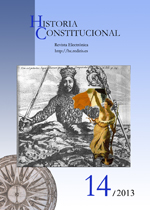The Bourbon Monarchy and the Señorío of Biscay in the second half of th XVIIIth Century: Center against periphery?
DOI:
https://doi.org/10.17811/hc.v0i14.364Keywords:
Monarchy, Señorío of Biscay, center-periphery relationship, clientelism and patronage, provincial laws (fueros)Abstract
The traditional political and institutional historiography has described the relationship between the Basque Provinces and the Bourbon Monarchy of the 18th Century as a continuous conflict between the central power and the periphery. In the last decades that interpretation has been deeply revised by the constitutional historiography and by the new social history. Taking those new historiographical approaches as starting-point, this paper analyses the relationship between the Señorío of Biscay and the Crown during the second half of the XVIII Century from a new viewpoint: the study of the institutional officials (Agente and Deputy at the court) and the relational network (patrons of the Señorío of Biscay at the administration of the Monarchy) that mediated between the provincial elite and the Monarchy.
Enviado el (Submission Date): 23/04/2013
Aceptado el (Acceptance Date): 5/05/2013
Downloads
Downloads
Published
Issue
Section
License
Authors who publish with this journal agree to the following terms:- Authors retain copyright and grant the journal right of first publication with the work simultaneously licensed under a Creative Commons Attribution License that allows others to share the work with an acknowledgement of the work's authorship and initial publication in this journal.
- Authors are able to enter into separate, additional contractual arrangements for the non-exclusive distribution of the journal's published version of the work (e.g., post it to an institutional repository or publish it in a book), with an acknowledgement of its initial publication in this journal.
- Authors are permitted and encouraged to post their work online (e.g., in institutional repositories or on their website) prior to and during the submission process, as it can lead to productive exchanges, as well as earlier and greater citation of published work (See The Effect of Open Access).
- Journal can use the published works for future publications.
- Authors must inform the journal of later publications of their text.


